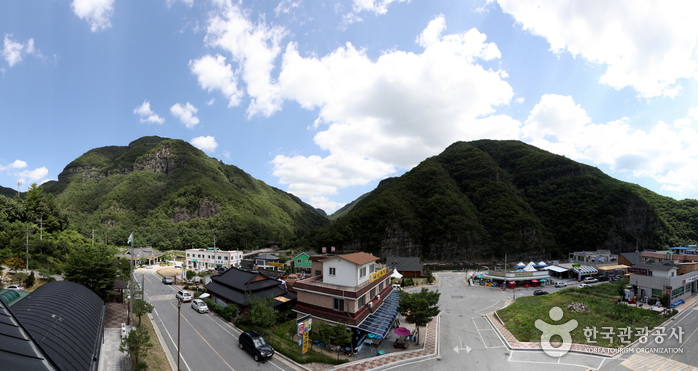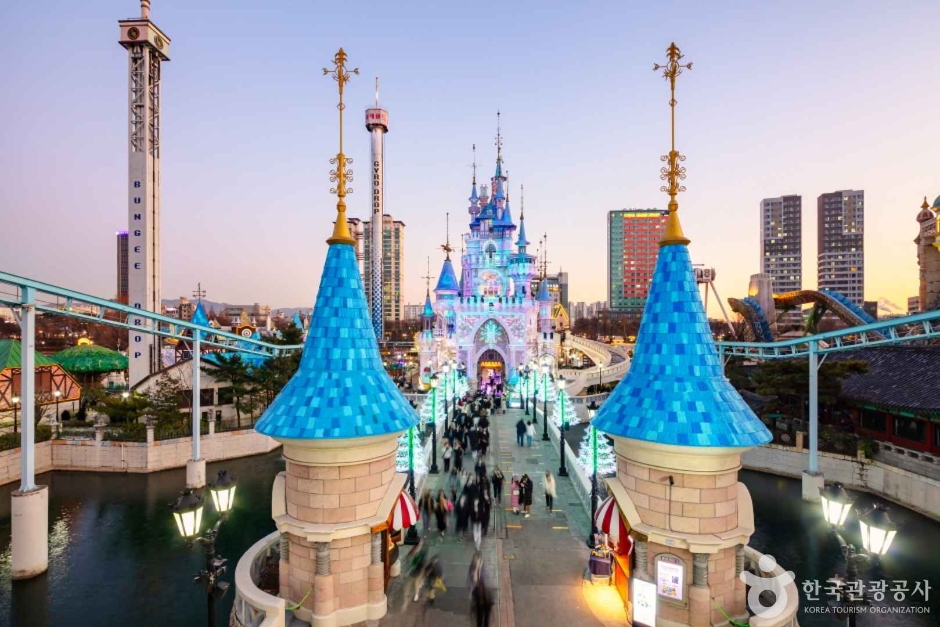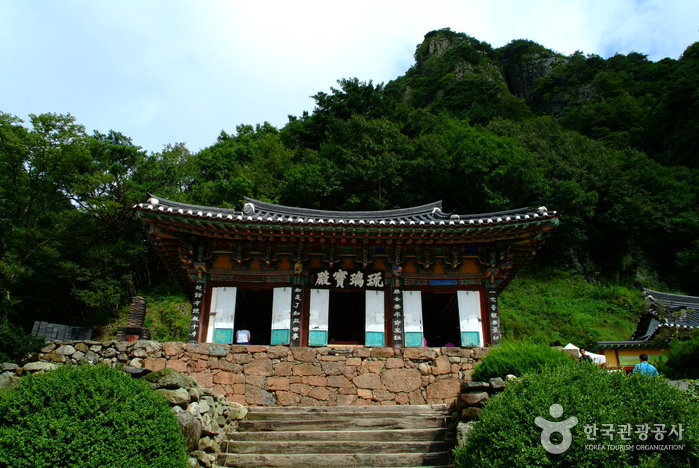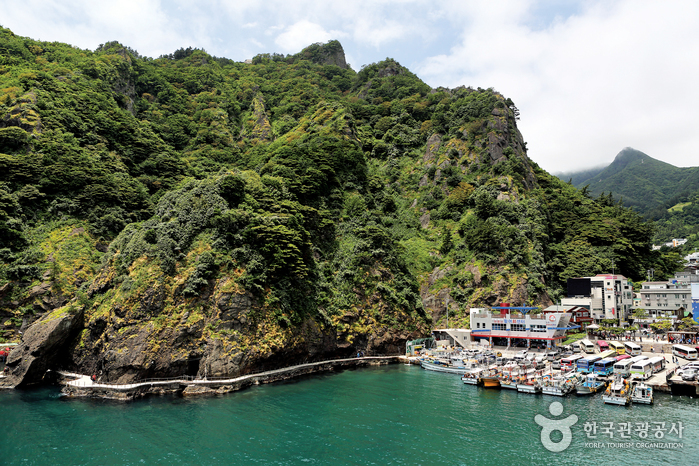Cheonbuldong Valley (천불동계곡)
2021-04-09
1091, Seoraksan-ro, Sokcho-si, Gangwon-do
+82-33-801-0900
As one of the Ten Sights of Seoraksan Mountain, the Cheonbuldong Valley is also called Seorakgol Valley, being a representative valley of the mountain. Along the valley covering about 7 km from Biseondae Rock to Daecheongbong Peak, visitors can enjoy the splendid scenery of various attractions including Waseondae Rock, Munjudam Pool, Ihodam Pool, Gwimyeonam Rock, Oryeon Falls, and Cheondang Falls. It has all magnificent views of Seoraksan Mountain. The Cheonbuldong Valley is also regarded as one of Korea’s top 3 valleys along with Chilseon Valley of Jirisan Mountain and Tamna Valley of Hallasan Mountain. It offers beautiful seasonal views every year, and among them, the autumnal foliage is considered the best scenery of the valley. Its colorfully-tinged autumnal leaves are in harmony with rocks in fantastic shapes, attracting many hikers in autumn.
Haeundae Beach (해운대해수욕장)
2024-11-26
264 Haeundaehaebyeon-ro, Haeundae-gu, Busan
+82-51-749-5700
Haeundae Beach is the most famous beach in Busan. The white sand beach is roughly 1.5 kilometers long, over a 30- to 50-meter wide area, creating a beautiful coastline before a shallow bay, making it perfect for swimming.
People flock to Haeundae Beach every summer. All kinds of accommodations from luxury hotels to private guesthouses have developed in the area around the beach, making this the perfect summer vacation spot. Haeundae Beach is also famous for various cultural events and festivals held throughout the year. Other facilities in the area include Dongbaekseom Island, Busan Aquarium, a yachting dock, BEXCO, driving courses and more.
◎ Travel information to meet Hallyu’s charm – TV series "Strong Girl Nam-soon"
Here, Nam-soon and her Mongolian mother shared a joyful moment creating the word “바다” (sea) with seashells on the sandy beach and taking pictures together.
Cheongnyangsan Provincial Park (청량산도립공원)
2022-07-26
39, Gwangseok-gil, Bonghwa-gun, Gyeongsangbuk-do
+82-54-679-6651
Cheongnyangsan Mountain, with an altitude of 870 meters, is hidden away from civilization. Attractions in the mountain are 12 peaks including Geumtapbong Peak, eight caves, Gwangchangpokpo Falls, and Cheongnyangsa Temple, built by Buddhist monk Wonhyo during King Munmu’s third year of reign during the Silla Period (57 BC - AD 935).
Behind the Cheongnyangsan Provincial Park’s entrance boulder is a monument with a poem inscribed on it by the famous scholar Toegye Yi Hwang of the Joseon period called Cheongnyangsanga. Aside from Toegye Yi Hwang, Wonhyo and Uisang, caligraphy master Gimsaeng, scholar Choi Chi-won, and many others came to this mountain to cultivate their arts. Their presence still lingers in legends, being retold to this day.
Lotte World(롯데월드 어드벤처)
2025-06-10
240 Olympic-ro, Songpa-gu, Seoul
+82-1661-2000
Operated by Lotte Group, Lotte World is the perfect spot for entertainment and sightseeing for Koreans and international tourists alike. The theme park is divided into the indoor Lotte World Adventure, and the outdoor lakeside Magic Island, with additional amenities including a shopping mall, folk museum, ice rink, hotel, and more.
Lotte World Adventure is the world's largest indoor amusement park, complete with top-of-the-line rides, fantastic parades and performances, and food from around the world. The Folk Museum displays miniature models of Korea throughout 5,000 years in history. Lotte World Garden Stage presents various themed musicals to match each season and Lotte World Star Avenue is the perfect place to experience Korean stars and the entertainment world.
Bonghwa Cheongnyangsa Temple (청량사(봉화))
2022-12-27
199-152, Cheongnyangsan-gil, Bonghwa-gun, Gyeongsangbuk-do
+82-54-672-1446
Located in Cheongnyangsan Mountain Provincial Park, Cheongnyangsa Temple was built by the great monk Wonhyo in 663, the 3rd year of King Munmu of the Silla Kingdom. According to the principles of feng shui, the area is an ideal place for a temple – with the 12 mountain peaks surrounding the temple like the petals of a lotus flower.
The temple is home to two precious historical remains; one is the board of Yuribojeon that King Gongmin of Goryeo wrote upon and the other is Jibul. Yuribojeon is the building where Yaksa-yorae-bul (the Medicine Buddha Statute) is housed and Jibul is a Buddha statute made of paper that was painted with gold.
At the back of the temple is Bosalbong Peak looking out towards Cheongnyangsan Mountain. A 30-minute walk along the hiking trail will lead the hikers to Eungjinjeon, a hermitage with a beautiful view where the great monk Wonhyo once stayed. Behind Eungjinjeon stands Geumtapbong Peak and the sheer cliffs below. The peak was named Geumtapbong (meaning ‘golden pagoda’ in Korean) since it looks like a nine-story pagoda with pine trees growing around the base. In the autumn, the beautiful red, gold and orange hues of the maple trees are a true sight to behold.
Ulleungdo Island (울릉도)
2022-07-28
66 , Dodong 2-gil, Ulleung-gun, Gyeongsangbuk-do
+82-54-790-6454
Ulleungdo Island is the seventh largest island in Korea. The volcanic island consists of 44 islets of varying sizes annexed around it. With many cliffs, the island is a popular spot for rock climbing. Many walking trails that connect the sea to the mountain and rivers are also available. A walk along the Ulleung Haedam-gil offers visitors a chance to see everyday life of people on the island as well as the island's natural beauty.
Andong Hahoe Village [UNESCO World Heritage] (안동 하회마을 [유네스코 세계유산])
2024-12-03
186 Jeonseo-ro, Pungcheon-myeon, Andong-si, Gyeongsangbuk-do
+82-54-852-3588
Hahoe Village is one of the most famous folk villages in Korea. Surrounded by the Nakdonggang River, the village is home to descendants of the Ryu clan of Pungsan, which still makes up 70 percent of the villagers. The village became even more famous after Queen Elizabeth of England visited on April 21, 1999, and President George H. Bush of the U.S.A. in 2005.
The village has many cultural treasures and important cultural materials, earning the village the designation of National Folklore Cultural Heritage in 1984. Hahoe Masks, a National Treasure, is also an important feature of the village.
Sobaeksan National Park (Gyeongsangbuk-do Region) (소백산국립공원(경북))
2023-02-17
Punggi-eup, Yeongju-si, Gyeongsangbuk-do
+82-54-638-6196
Sobaeksan National Park was designated as the 18th national park in December 1987. The features of Sobaeksan National Park include wildflowers and royal azaleas in spring and snowy scenery in winter. The mountain borders three provinces and four cities. Attractions include various peaks, temples, and waterfalls. The mountain is especially popular in May when royal azaleas are in full bloom and a natural forest tunnel is formed. Birobong Peak of the mountain is covered with snow six months of the year and is called the Alps of Korea.
Juwangsan National Park (주왕산국립공원)
2023-03-13
169-7, Gongwon-gil, Cheongsong-gun, Gyeongsangbuk-do
+82-54-870-5300
Juwangsan Mountain (alt. 720.6 m) is located in the Baekdudaegan Mountain Range, the backbone of the Korean peninsula. The mountain features deep valleys and many sheer rock cliffs to make it the third-largest rocky mountain in the country. Juwangsan Mountain was recognized as a tourist attraction on May 30, 1972, and became the 12th national park a few years later on March 30, 1976. The park is relatively small, filling in an area of just 105.582 ㎢ but it is great for a leisure walk with walking trails along the valleys up to waterfalls.
Juwangsan Mountain was called Seokbyeongsan Mountain during the Silla dynasty due to the many stone peaks jutting out but has been called Juwangsan Mountain since the Unified Silla period. In addition to these tall rocky peaks, Juwangsan National Park also includes four waterfalls, caves, Daejeonsa Temple, and other attractions for a comprehensive tourist site.
Sosuseowon Confucian Academy [UNESCO World Heritage] (소수서원 [유네스코 세계문화유산])
2020-12-04
2740, Sobaek-ro, Yeongju-si, Gyeongsangbuk-do
+82-54-639-7691
Sosuseowon Confucian Academy is situated at the foothills of Sobaeksan Mountain. Sosuseowon was the first to receive a royal charter as a private Confucian academy along with financial support and acknowledgement by the king. This academy was originally founded under the name Baegundongseowon in 1542 by a Confucian scholar Ju Se-bung, who was also the magistrate of Punggi County at the time. Baegundongseowon first started as an academic institution that enshrined a memorial tablet of An Hyang, a Confucian scholar whom Ju Se-bung had deep respect for. After Ju Se-bung left the county, Toegye Yi Hwang, a renowned Confician scholar, became his successor and made an official request to the king to be granted a royal charter. The request was well received, and the king renamed the institution to its current name, Sosuseowon.






![Andong Hahoe Village [UNESCO World Heritage] (안동 하회마을 [유네스코 세계유산])](http://tong.visitkorea.or.kr/cms/resource/38/3421438_image2_1.jpg)

 English
English
 한국어
한국어 日本語
日本語 中文(简体)
中文(简体) Deutsch
Deutsch Français
Français Español
Español Русский
Русский